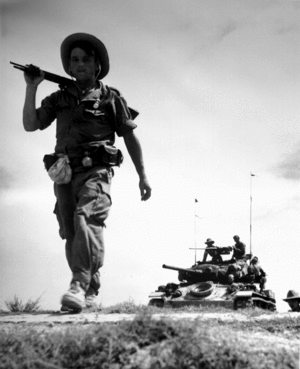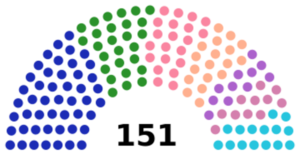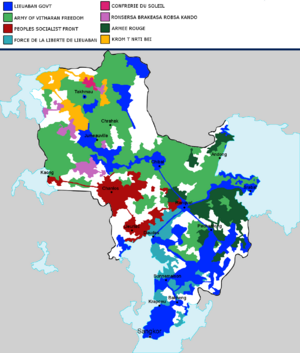Lieuaban
Senatorial Republic of Lieuaban République Sénatoriale de Lieuaban (Notreceauen) | |
|---|---|
Motto: Les Mots Ont un Sens | |
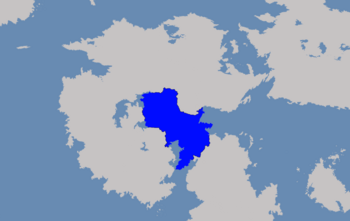 Lieuaban in Pardes | |
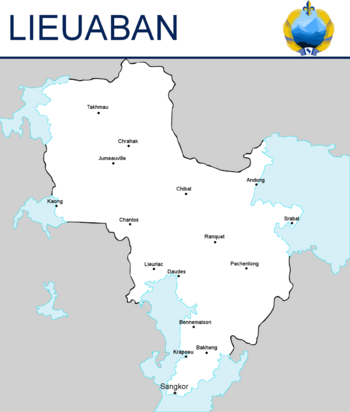 Map of Lieuaban | |
| Capital | Sangkor |
| Largest City | Sangkor |
| Official language | Notreceauen |
| Ethnic groups |
|
| Religion | |
| Demonym(s) | Lieuaban |
| Government | Parliamentary Republic |
| |
| Legislature | Sénat Républicain |
| Formation | |
• Colonization of Lieuaban | 1805 |
• Independence from Notreceau | April 2nd, 1959 |
| Area | |
• | 2,618,976 km2 (1,011,192 sq mi) |
| Population | |
• 2010 estimate | 74,628,684 |
| GDP (nominal) | estimate |
• Total | 315,000 million (5) |
• Per capita | $4,873 (5) |
| HDI | 0.598 medium |
| Currency | Lieuaban Monale (l₥) |
| Date format | dd/mm/yyyy (AD) |
| Driving side | right |
The Senatorial Republic of Lieuaban or simply, Lieuaban is a parliamentary republic located in the region of Pardes. It borders Kolenomai to the south. It is predominately located on a series of mountain ranges rich in minerals that are crucial to modern energy and computing such as Coltan, Copper, Tritium, and Iridium. Lieuaban is a former colony of Notreceau and since its independence in 1959 has become an export hub centered around its capital and one of the largest cities in the world Sangkor.
While Lieuaban's capital Sangkor enjoys being one of the most developed areas of the world, the rest of the country is known as some of the poorest places in the world. It has been described by observers that Lieuaban is a city state that controls the country side in name only, and only loosely able to draw from the resources of its northern areas. Tension in Lieuaban predates it's independence, with many groups locked in ethnic, religious, and economic conflict for centuries. Reports estimate over 200 people die every day from violence in the troubled country of Lieuaban, and outside the city of Sangkor it is considered a failed state.
Much of Lieuaban's economy centers around the trade of rare earth minerals and other resources mined from the northern part of the nation. Many international organizations work with the government in Sangkor to export such minerals for use on the world market. Other exports include some computer parts manufactured in government-controlled areas, machine parts, consumer goods, and spices. The black market of Lieuaban which is estimated to be 40% of Lieuaban's economy centers around the illegal trade of minerals mined by groups not associated with the government, drugs and weapons traded in areas not controlled by the government, and human trafficking taking advantage of the lawlessness of Lieuaban's countryside. While exact numbers are hard to come by due to the situation in the country, it is also estimated that another export, terrorism, is quickly on the rise in the nation as groups from all parts of the globe use it as bases of operation with the support of Lieuaban's many factions.
Lieuaban is ruled over by the 151 person Sénat Républicain which convenes within the Sévérine located in downtown Sangkor. Senators are elected for 4 year terms via indirect election in which victors are determined by popular vote for party electors. A 5 senator Conseil d'Administration is nominated and elected every 6 months by the senate and acts as the head of state and government, overseeing all branches of Lieuaban's bureaucracy, including the Armée Territoriale de Lieuaban. The governing constitution of Lieuaban is the Sévérine Oath, a two-hundred page document laid out by the last governor of the Colonial Authority of Lieuaban, Louise Sévérine, to the people of the new nation.
Etymology
The origin of the name Lieuaban comes from the Notreceauian name for the southern lowland areas of their colony which is situated around Sangkor. It is translated as meaning "Forsaken Land" by the colonial authority as it's harsh tropical climate coupled with a plethora of insects and its unwelcoming people who often fought Notreceauian authorities at every turn earning the colony the name which went with its reputation. Today Lieuaban stands as the national name out of tradition and a sense of earned pride as a tough-going nation of hard peoples. Though some ethnically Vitharan peoples denounce the use of the Notreceauian given name for the nation, claiming it illustrates the lack of control by the native people's over their nation.
History
The lands consisting of modern day Lieuaban were inhabited by a collection of pre-Vitharan people groups each migrating from northern lands following the encroaching ice age. Little archeological evidence shows much of civilization prior to the iron age however as time goes on more traces of settlement beginning to appear showing many of the migrating tribes settling down in the area of present day Lieuaban. Several hundred years BC signs of a massive extermination of what has come to be called the pre-Vitharan people by means of genocide carried out by those ancestors to present day Vitharans. Five-hundreds years after which the first historical Vitharan civilization is founded.
In the 1st through 5th century the Vitharan civilization grew to encompass much of present day Lieuaban and surrounding lands, mainly living off of crops in the low lands near present day Pachentong. These people practiced a polytheistic religion known as Langtok and enjoyed many years of peace with neighboring kingdoms. Sometime post 5th century however, major internal strife created a rift in the Holy Vitharan Kingdom, where three sons of the late King each formed their own state independent of the other. These came to be known as the Three Crowns of Powplai and in the years leading up to the colonial period they each vied for supremacy with the other, hoping to reform the Vitharan Kingdom.
None would be able to achieve this however, as come the 18th century many distant foreign powers began to step into Vitharan affairs. Seeking the many riches of its northern mountain ranges, these nations cut apart Vitharan civilization into even more
warring states in search of what turned out to only be small deposits of gold. While most of these powers did not move beyond outposts in Vithara, in 1805 the colonial power of Notreceau officially annexed Vithara and renamed it to Lieuaban or "Forsaken Land" as it is known in their native tongue.
For over one-hundred years the colony of Lieuaban was exploited for its mineral riches in the north and inexpensive labor in more populous areas of the south. Within the colonial capital of Sangkor the government wrestled for control of supply routes with local groups, including an increasingly popular Vitharan nationalist movement which harried at colonial attempts to extract ores from the northern mountains, making it an increasingly expensive endeavor. In the early 20th century due to increasing political strife in the Notreceau homeland, the colonial authority of Lieuaban was disbanded, giving over control of the nation to a transitional ethnic-Notreceauen government lead by Louise Sévérine that went on to form the République Sénatoriale de Lieuaban.
In the late 20th century the continued ethnic strife between native Vitharans and colonial Notreceauen boiled over and sparked what is known as the Kouprey Revolt, a war in which the self-proclaimed People's Republic of Democratic Vithara consolidated many splintered factions into one effort to push the Notreceauen out of their lands. This conflict lasted for six months in which government forces of Lieuaban were subsequently defeated and pushed back to the capital of Sangkor where the major trade hub remained under siege for seven weeks. What promised to be a disaster for the Lieuaban Notreceauen turned into a miracle when the National Directorare of Notreceau intervened militarily, breaking the PRDV forces and reinstating Lieuaban government control over the whole of the nation. Since then some form of Notreceau presence has been known in the struggling nation.
Geography
Lieuaban is a moderately large nation of encompassing an area of 2,618,976 square kilometers that lies in the tropics and sub-tropics. Lieuaban's landscape is characterized by mountains to the north-west and south east and lowlands in between. Major rivers run between both the southern and eastern coasts and throughout the plains and rolling hills there can be found thinly forested.
In the north rises the Oblot mountain range that rises to Lieuaban's highest point of 8,586 m. Here the mountain range splits into two twin ranges that flank a forested valley that flow into the lakes of Talkuat and Laotai. The coastal areas of Lieuaban are tropical in nature and rise into the central Lieuaban plain.
Climate
The coastal and plain areas are subject to warm tropical temperatures year around with mild winters. While the higher mountain ranges are subject to harsher colder climates.
Politics
Lieuaban is a Unicameral Parliamentary Republic where power is vested in a 151 person Sénat Républicain which is elected every four years via indirect election by all persons over the age of 18 in Lieuaban. Various political parties which are registered through referendum are granted authorities through election who then appoint senators to serve in the Sénat. Every 6 months the Sénat elects among themselves a five seat Conseil d'Administration which handles the role as head of state and government overseeing the eight different ministries of the government of Lieuaban. This form over government has existed since 1959 when Louise Sévérine the last governor of the Colonial Authority of Lieuaban signed what is now known as the Sévérine Oath with a dozen other aristocrats to form the first sessions of the Sénat Républicain.
The Sévérine Oath, which is the de-facto constitution of Lieuaban, lists many freedoms that are guaranteed to the citizens of Lieuaban. Freedoms such as speech, assembly, religion, and the right to bear arms are listed within the original oath that is on display in the center of the Sévérine. However, since its inception in 1959 the right to bear arms was amended following the Kouprey Revolt to enforce strict standards on who may legally purchase firearms. It has been noted that many of the freedoms outlined in the oath are rarely upheld for non-desirables, or peoples who refuse association with the Lieuban government. International observers often criticize Lieuaban for its lack of respect for the rights of those citizens who actively descent to the control of Lieuaban by the Notreceauen lead government. Arrests for unlawful assembly, possession of weapons, and speech critical to the government are frequent in areas of the country that are under martial law, known as zones occupées par l'armée.
Within the Sénat Républicain there are many different political parties each with their own agenda for the nation. While most of these parties align with the philosophy of Louise Sévérine and a Notreceauen controlled nation, there are in fact many up and coming Vitharan parities eager to influence policy making in Sangkor towards their nationalistic ideals. Parties such as the Union Républicaine, Alliance des Démocrates Catholiques, and the Parti de la Réforme Sociale uphold a large block of the Sénat and develop a majority of the Notreceauen concentric policy which focuses on the export of Lieuaban's natural resources to the world market for economic gain. While parities such as the Parti de l'indépendance Vitharan, Parti de la liberté du nord, and Parti Socialiste Populaire de Vitharan seek an independence from the Notreceauen controlled state and seek to construct their own Vitharan ethnic state. While the Notreceauen collation holds on to much power in the government, the recent advances of Vitharan politics have caused a disruption.
The government and Sénat Républicain itself are seated in the Sévérine, a large palace in the center of Sangkor that used to house the colonial governor of Lieuaban. From the Sévérine the eight ministries of Lieuaban and much of its foreign relations are controlled under strict security. In 1961 a large chamber was added on to the Sévérine to house the Sénat Républicain for its sessions and was fashioned to match the late colonial design of the rest of the palace. The Conseil d'Administration also meets and controls the function of the government from within the Sévérine.
Factions of Lieuaban
Despite the fourishing southern lands of the country surrounding the capital of Sangkor, Lieuaban is a very divided country full of ethnic strife, religious conflict, and above all armed warfare on a consistent civil war scale. The various factions in the Lieuaban countryside wrestle for control of the nation and it's resources not only with the government but with each other. Communists fight nationalists to decide who will be the dominant power for an independence movement. Vitharan fight Notreceauens to decide to the fate of what ethnicity should rule the nation. Even Notreceauens fight the government to distance themselves from foreign powers who exploit Lieuaban through the Sangkor government. Lieuaban ever has been and some say ever will be in a state of tension as blood is spilt on a daily basis.
International observers have associated the ongoing conflict in Lieuaban with over 200 deaths a day. These deaths are associated with armed conflict, corruption, crime, and terrorism, each playing a key factor in destabilizing the countryside. The main prize these factions fight over is the important resources of Lieuaban's mineral reserves, rare earth metals that are crucial to the modern economy and often have a trickle affect to the international markets when they are not readily available. Unfortunately the ports of Sangkor are not the only way these resources are able to be brought to markets around the world. The Lieuaban black market is notorious for its exploitation of resources, some being beyond the minerals the government so eagerly wishes to control. In fact over 35% of the black market in Lieuaban can be associated with one of three things: weapons, drugs, and people.
Since the Kouprey Revolt, few groups have been able to amass strength enough to push the Lieuaban government back to their fortress in the south of the country around Sangkor. Many of these factions are often plagued with infighting, disorganization, and constant harassment from other factions. Government forces have often enjoyed this, allowing then to accomplish their mission to secure routes for resources to be exported, however much fighting still takes a toll on military resources to quell factions as they become larger and more powerful.
Factions within Lieuaban have a wide range of ideologies each with their own caveats to which they refuse to work together. Some of the most notable factions such as the Army of Vitharan Freedom or the People's Socialist Front seek to create an independent state for ethnic Vitharan people under their own political ideologies. But this sort of uprising is not exclusive to ethnic Vitharans, as the Force De La Liberte De Lieuaban, a ethnic Notreceauen faction seeks to liberate the people of the nation from an ever controlling government influenced by foreign powers.
Even still religion plays a part in some of the tension such as the Ronsersa Brakeasa Robsa Kando which seeks to force its own religious independence from the government authorities, or the Armee Rouge a ultra-catholic group which seeks to create a state in Lieuaban exclusive for Catholics. The mysterious Confrerie Du Soleli has most recently appeared on the scene promoting a violent occult religion that has drawn people of all ethnicities and creeds under its banner. Many groups play their hands along these lines hoping to push their own religious agenda amidst the chaos.
Lastly there are factions who simply wish to use the fractured and lawless areas of the nation around them for self gain and crime. Most notably of these is the Krom T Nrti Bei a union of three warlords who control much of the black market of northern Lieuaban, dealing in drugs, weapons, and the slave trade.
Other groups preying on the situation also include state and non-state actors. Private military corporations have been known to use the chaos of Lieuaban as training for their soldiers of fortune much like groups have terrorists from around the globe have set up training camps. What agenda these factions have for the future of Lieuaban is uncertain, but it is clear that foreign interests are beginning to seep into the already destabilized nation.
Foreign Relations
Foreign relations of Lieuaban are handled by the Ministère des Affaires Etrangères which administers both missions external to nations around the world as well as those missions from other nations in Lieuaban. Lieuaban maintains embassies with most nations as it's international cooperation is a focus of the Sangkor government to give it support and leverage within it's internal struggles against separatist factions. Lieuaban is a member of many organizations throughout the world giving itself a voice in world affairs.
Lieuaban's government presents itself to the world as the most legitimate, stable, and safe option to support for the extraction of critical resources in Lieuaban. World markets, especially in the technology industry, depend on resources mined and manufactured in Lieuaban to produce many circuits, mother boards, and batteries. The foreign mission of the Ministry is often busy securing investments from international partners in both the infrastructure for mining and producing these products, as well as security for the extraction. Recently other concerns from international powers such as terrorism basing itself in lawless areas of Lieuaban or crime exports such as drugs, arms, and slaves have been a contentious topic for the struggling nation to confront as its image is often tarnished by its lack of control in its own borders.
With its neighbors, Lieuaban is often at odds due to the large amounts of violence and crime that it inadvertently exports through its uncontrolled borders in the north. While the government works its best to try and meet the needs of its regional partners, it often falls short as it's over taxed border security and military are unable to stop the flow from around Lieuaban. While this has been troubling for the nation, partners like Notreceau which since the violent conflicts of the 70s and 80s have maintained a military and advisory presence within the nation, give it some relief in its under-resourced struggles. This has helped stem the tide of violent exports from the nation, but concerns from neighbors have not lessened, especially since the nationalistic Army of Vitharan Freedom controls vast swaths of the borders of Lieuaban and does little to control crime within it's territory.
Military
The Armée Territoriale de Lieuaban is broken into three branches: the Armée Territoriale which is the land component and largest branch, the Armée de l'Air Territoriale the air component, and finally the Armée Marine Territoriale the naval component and smallest branch. Each of these branches is controlled by the Ministre de l'Interieur and answer to the civilian minister as well as the Conseil d'Administration as the commander and chief. The main focus of the military is the defense of the homeland and its stability, using most of its resources combating dissident groups opposed to the Sangkor government.
Lieuaban divided is a large focus of the government and its military forces, the Armée Territoriale de Lieuaban is an under-resourced, under-trained, and ineffective force at combating the internal threats to the Notreceauian controlled state. Since independence from Notreceau the organization of the military has been a struggle, without the resources from the motherland the forces of Sangkor found themselves to be outmatched by the growing nationalist movement. During the 1979 Kouprey Revolt the government forces were completely routed as their lack of command structured proved to be the undoing as more zealous and organized ethnic forces closed in from the north. It was not until the Notreceau intervention did Sangkor regain control of the nation, and since then its armed forces have depended on the aid and advisement of Notreceau to continue operations.
The Armée Territoriale de Lieuaban has also found itself in the 21st century to be fighting a conflict with middle-20th century equipment, and with little resources to divert to modernization, will be for some time. It is for this reason that private military corporations have frequently been a part of the Lieuaban battle plan, a tactic that has earned the ire of internal and external observers due to their numerous human rights violations. While more elite units remain in the south to protect the economic hub of Sangkor, expendable units are often sent with lackluster gear and training to protect the routes connecting the government-controlled territories that resources often travel along. These patrols have been nicknamed garçons sanglants, due to the high mortality rate of the young soldiers participating in them.
Economy
Agriculture
The central plains of Lieuaban provide lush soil for growing crops, particularly rice which is harvested in mass by those native to the region daily. The sub tropical to tropical climate makes growing crops ideal as well as giving moist environment to grow. Due to conflict in the nation little agricultural exports are made from Lieuaban, but the central region of the nation provides enough food for the masses. Whether that food makes it to all corners of the nation is another story.
Energy
The struggles of providing energy to parts of the nation that are not controlled by the government has become an increasing problem. The government largely controls all sources of energy and electrical grid, with lawless areas controlled by dissident factions largely live in the dark. The main source of power in the south for major cities like Sangkor is the nuclear plant at Trois rivières, operating on nuclear fuel donated and closely monitored by the Notreceaun government. Other coal and gas planets exist around the country, but in areas not controlled by the government they lay largely dormant.
Industry
The most dominant sector of the economy of Lieuaban is the mining industry which focuses on resources such as Coltan, Copper, Tritium, and Iridium, each critical to the world technology market. These resources are largely found in the northern part of the nation where the are extracted from the mountains and brought to Sangkor to be shipped to market. There in the capital is a large industry of manufactured technology components which use some of these resources. This forms the biggest sector of industry in the nation which is only threatened by the manufactured goods market of Sangkor.



